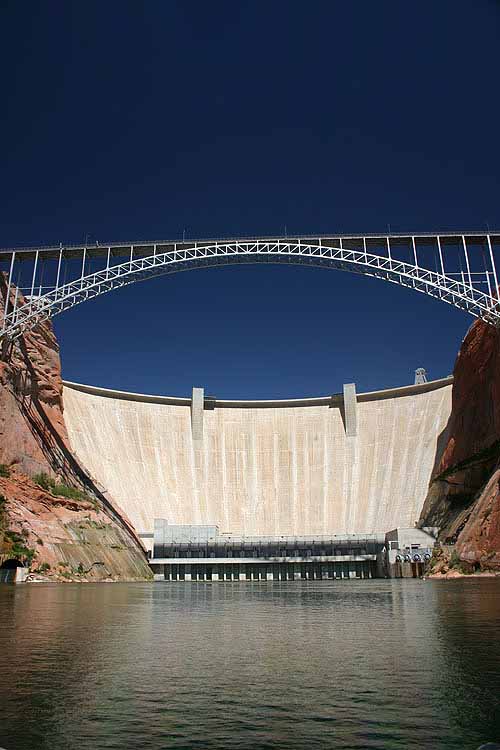
Glen Canyon Dam
The Glen Canyon Dam is a dam on the Colorado River at Page, Arizona, USA. It provides water storage for the arid southwestern United States, to generate electricity for the region\’s growing population, and to provide water recreation opportunities. The dam generates an average of 451 megawatts, 6% of the total electricity generated in Arizona and 13% of that generated in Utah where most of Lake Powell resides, which amounts to a total carbon dioxide savings of over 5 million metric tons,[1] although it has a maximum capacity of 1300 megawatts.[2] Damming the river flooded Glen Canyon and created a large reservoir called Lake Powell.
Just downstream from the dam is an arch bridge that carries U.S. Route 89. Also nearby is the 2280 megawatt, coal-fired Navajo Generating Station.
Despite continuing opposition from many environmental groups, the dam, Lake Powell, and the Glen Canyon National Recreation Area remain popular tourist destinations. Continued population growth in the western and southwestern United States places more demands on the system of dams and reservoirs on the Colorado River for water, power, and recreational purposes, which are important to the infrastructures and economies of the western United States.[3]
Completed in 1964, Glen Canyon Dam bridge is 1,560 ft (475.5 m) long and 700 feet (213 m) above the Colorado River. It is the 4th highest bridge in the U.S. Before it and the downstream Navajo Bridge were built, it was a 192-mile (309 km) drive to the canyon\’s other side.Contents [hide]
1 History
1.1 Environmental opposition to dam site
1.2 Continued opposition
1.3 Important events in 1983, 1984
2 Structure, operations, and reservoir water allocations
2.1 Structure
2.2 Operations
2.3 Water allocation
3 Environmental impacts
4 See also
5 References
6 External links
[edit] History
The dam is part of the Colorado River Storage Project for the Upper Colorado Basin. It is located about 4.5 miles (7.2 km) south of the border between Utah and Arizona. According to the U.S. Bureau of Reclamation who operates the dam, \”The project furnishes the long-time regulatory storage needed to permit States in the upper basin to meet their flow obligation at Lees Ferry, Arizona, (as defined in the Colorado River Compact) and still use their apportioned water.\”[4]
Construction of the dam began in 1956 by the industrial conglomerate, Merritt-Chapman & Scott. Although the dam was not dedicated until 1966, it was able to begin blocking the flow of the river in 1963